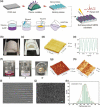Self-Assembly of Strain-Adaptable Surface-Enhanced Raman Scattering Substrate on Polydimethylsiloxane Nanowrinkles
- PMID: 38888085
- PMCID: PMC11223597
- DOI: 10.1021/acs.analchem.4c01212
Self-Assembly of Strain-Adaptable Surface-Enhanced Raman Scattering Substrate on Polydimethylsiloxane Nanowrinkles
Abstract
Flexible surface-enhanced Raman scattering (SERS) substrates adaptable to strains enable effective sampling from irregular surfaces, but the preparation of highly stable and sensitive flexible SERS substrates is still challenging. This paper reports a method to fabricate a high-performance strain-adaptable SERS substrate by self-assembly of Au nanoparticles (AuNPs) on polydimethylsiloxane (PDMS) nanowrinkles. Nanowrinkles are created on prestrained PDMS slabs by plasma-induced oxidation followed by the release of the prestrain, and self-assembled AuNPs are transferred onto the nanowrinkles to construct the high-performance SERS substrate. The results show that the nanowrinkled structure can improve the surface roughness and enhance the SERS signals by ∼4 times compared to that of the SERS substrate prepared on flat PDMS substrates. The proposed SERS substrate also shows good adaptability to dynamic bending up to ∼|0.4| 1/cm with excellent testing reproducibility. Phenolic pollutants, including aniline and catechol, were quantitatively tested by the SERS substrate. The self-assembled flexible SERS substrate proposed here provides a powerful tool for chemical analysis in the fields of environmental monitoring and food safety inspection.
Conflict of interest statement
The authors declare no competing financial interest.
Figures





Similar articles
-
Uniform Spray-Coated Flexible SERS Substrates for Enhanced Molecular Detection.Chem Asian J. 2025 Jun 19:e00405. doi: 10.1002/asia.202500405. Online ahead of print. Chem Asian J. 2025. PMID: 40536074
-
Flexible, robust, and highly stable gold nanoparticle-decorated aramid nanofiber SERS substrates for ultrasensitive detection of hazardous chemicals in harsh environments.Mikrochim Acta. 2025 Jun 26;192(7):458. doi: 10.1007/s00604-025-07323-6. Mikrochim Acta. 2025. PMID: 40571768
-
Surface Modified Ag Nanowires as Effective, Flexible-Patterned SERS Substrates for the Detection of Fishery Drugs.Langmuir. 2025 Jul 15;41(27):17633-17643. doi: 10.1021/acs.langmuir.5c01229. Epub 2025 Jul 2. Langmuir. 2025. PMID: 40600622
-
Assessing the comparative effects of interventions in COPD: a tutorial on network meta-analysis for clinicians.Respir Res. 2024 Dec 21;25(1):438. doi: 10.1186/s12931-024-03056-x. Respir Res. 2024. PMID: 39709425 Free PMC article. Review.
-
Prevalence and odds of anxiety and depression in cutaneous malignant melanoma: a proportional meta-analysis and regression.Br J Dermatol. 2024 Jun 20;191(1):24-35. doi: 10.1093/bjd/ljae011. Br J Dermatol. 2024. PMID: 38197404
Cited by
-
Recent Advances in Food Safety: Nanostructure-Sensitized Surface-Enhanced Raman Sensing.Foods. 2025 Mar 24;14(7):1115. doi: 10.3390/foods14071115. Foods. 2025. PMID: 40238249 Free PMC article. Review.
-
Introduction and Development of Surface-Enhanced Raman Scattering (SERS) Substrates: A Review.Nanomaterials (Basel). 2024 Oct 14;14(20):1648. doi: 10.3390/nano14201648. Nanomaterials (Basel). 2024. PMID: 39452983 Free PMC article. Review.
-
Grating/microcavity arrays on lily petal replicas as dual-functional SERS substrates for rapid monitoring of thiram on fruit surface and malachite green in surface water.Mikrochim Acta. 2025 Feb 12;192(3):148. doi: 10.1007/s00604-025-07025-z. Mikrochim Acta. 2025. PMID: 39934430
References
-
- Fleischmann M.; Hendra P. J.; McQuillan A. Raman Spectra of Pyridine Adsorbed at a Silver Electrode. Chem. Phys. Lett. 1974, 26 (2), 163–166. 10.1016/0009-2614(74)85388-1. - DOI
-
- Luong H. N.; Nguyen N. M.; Nguyen L. N. T.; Tran C. K.; Nguyen T. T.; Duy L. T.; Nguyen N. P.; Huynh T. M. H.; Tran T. T.; Phan B. T.; et al. Detection of Carbendazim by Utilizing Multi-Shaped Ag NPs Decorated ZnO NRs on Patterned Stretchable Substrate through Surface-Enhanced Raman Scattering Effect. Sensors Actuators A Phys. 2022, 346 (6), 113816 10.1016/j.sna.2022.113816. - DOI
-
- Ma Y.; Du Y.; Chen Y.; Gu C.; Jiang T.; Wei G.; Zhou J. Intrinsic Raman Signal of Polymer Matrix Induced Quantitative Multiphase SERS Analysis Based on Stretched PDMS Film with Anchored Ag Nanoparticles/Au Nanowires. Chem. Eng. J. 2020, 381, 122710 10.1016/j.cej.2019.122710. - DOI
LinkOut - more resources
Full Text Sources
Miscellaneous

